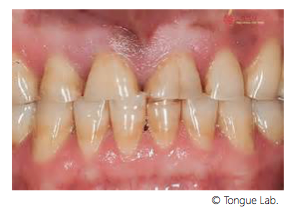Temporomandibular dysfonctions (TMD)
The Temporomandibular Joint (TMJ) is the joint that connects the mandible (lower jaw) to the skull. Tongue flare-ups can alter the growth of the mandible, alter dental balance, unbalance the ATMs and induce pain during the day, especially during chewing. These disorders are called Maneuvering Device Dysfunctions. DAM can be promoted by thumb sucking in children and by para-functions such as bruxism during sleep in adults.
Temporomandibular Joint
Description
Temporomandibular Joints (TMJ) are at the junction of the mandibles (lower jaws) and temporal bones of the skull on either side of the face, in front of the ears. They allow the mandible to move in all 3 dimensions when opening the mouth, chewing, phonation, swallowing, yawning… This very complex joint is very much in demand.
The dysfunctional tongue causes ATM disorders (meniscal dislocation, condylar dislocation, arthropathy, etc.).
Consequences
This displacement of the condyle leads to ATM disorders, sometimes painful cracking of the jaw or severe pain during chewing. This can then worsen into an inflammation of the ATM that will cause permanent pain spreading to the ear canal.
People with an ATM disorder will often tend to adopt a laterally shifted posture in order to reduce the pain due to inflammation of one of the ATMs. This can result in back and shoulder pain down to the lower body.
Prevalence
According to studies, between 5 and 10% of the population is affected by ATM disorders. This percentage is higher for women (2-18%) than for men (0-10%).
Treatment
Correcting the lingual dysfunction is the same as treating the cause and allows the ATM to recover and maintain its natural functioning.
In the absence of tongue reeducation, orthodontic treatment, surgical or other, aimed at rebalancing the TMJ will not be stable, as the tongue always exerts unbalanced unilateral pressure.
Bruxism
Description
Bruxism is a “para-function” characterized by a strong clenching of the unconscious teeth during the night or day accompanied by a movement of the mandible causing teeth to grind.
It is important to distinguish between daytime bruxism and sleep bruxism, which we will focus on.
Although its causes have not yet been fully elucidated, it is nevertheless established that sleep bruxism is linked to respiratory disorders and a dysfunction of the tongue. The clenching of the teeth is a defensive reaction of the body to breathing difficulty, to cause swallowing during sleep: the lingual dysfunction causes lateral movements of the mandible, creating grinding.
Consequences

The consequences of bruxism are dental disorders (dental wear or fractures…), headaches (headaches), joint pain in the TMJ, or pain in certain facial muscles. In addition, the squeaking characteristic of bruxism can be very unpleasant for the bed partner.
Prevalence
Sleep bruxism affects more young people (18% to 30%) than older people (8%). On the other hand, 50% of apneic patients, whose cause is very often linked to lingual dysfunctions, also suffer from nocturnal bruxism.
Treatment
A reeducation of the lingual functions is a necessary accompaniment to treat permanently the disorders of the manducator apparatus and bruxism.
Lire les autres chapitres :

